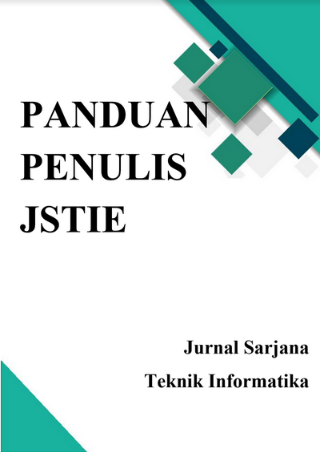RANCANG BANGUN SISTEM HOTSPOT MENGGUNAKAN CAPTIVE PORTAL
DOI:
https://doi.org/10.12928/jstie.v1i1.2522Abstract
Pengelolaan jaringan hotspot yang tidak teratur merupakan kendala pada clients hotspot ketika mengakses jaringan yang salah satunya pemakain password yang dapat dipakai secara bersama-sama. Permasalahan utama pada jaringan yang telah ada diPimpinan Pusat Muhammadiyah Yogyakarta berupa pengawasan  client hotspot (pemakai internet) terhadap akses jaringan serta gangguan saat satu password digunakan secara bersama sehinggga server yang diakses mengalami kelambatan. Maka diperlukan penelitian untuk mengidentifikasi jaringan hotspot yang telah ada.
Subjek dalam penelitian ini adalah rancang bangun sistem hotspot menggunakan captive portal. Pengumpulan data dalam penelitian ini menggunakan metode observasi, wawancara, metode studi literatur. Sistem yang dibangun adalah captive portal menggunakan aplikasi freeradius dan chillispot. Penyusunan meliputi dengan prosedur antara indentifikasi masalah, analisis kebutuhan, perancangan jaringan, perancangan sistem, serta implementasi jaringan hotspot menggunakan metode captive portal, sedangkan pengujian sistem dilakukan dengan black box dan alpha test.
Hasil penelitian dapat bekerja dengan optimal pada rancang bangun sistem hotspot menggunakan captive portal dan sistem yang mampu meningkatkan keamanan akses jaringan pada Pimpinan Pusat Muhammadiyah Yogyakarta. Sehingga mempermudah karyawan dalam memantau kegiatan client yang sedang memakai jaringan hotspot. Berdasarkan hasil uji coba tersebut dapat disimpulkan bahwa sistem captive portal ini dapat diterapkan pada sistem hotspot diPimpinan Pusat Muhammadiyah Yogyakarta.
Kata Kunci : Captive portal,Chillispot,Freeradius,Internet,Hotspot.References
Gesit Singgih Febyatmoko, 2006, “Sistem Otentikasi Otorisasi dan pelaporan koneksi user pada jaringan wireless Chillispot dan server Radiusâ€, Surabaya, Skripsi
Lilik Suheri, 2009, “Analisis Manajeman Hotspot dengan Captive Portalâ€, Semarang, Skripsi.
Permadhi Santosa, 2011,â€Perancangan Prototype Radius Server dan Chillispot untuk Otentikasi Pengguna Jaringan Wirelessâ€. Skripsi, Bandung.
Widhargo, 2009, "Autentikasi Jaringan LAN dan Wireless menggunakan Raouter Pfsense dengan Radius", Skripsi,Surakarta
Yuswira Efendi,2008 " Desain Dan Implementasi Autentikasi jaringan Hotspot menggunakan Chillispot autentikasi system dan radius server pada GNU/Linux 4.0 r3 ETHâ€, Surakarta, Skripsi
http://ndra.gmib26.net/2010/06/install-easyhotspot-dan-konfigurasi freeradius-serta-coova-chilli-di-ubuntu-10-04-lts-server-edition(diakses rabu,30 mei 2012).
Downloads
Published
Issue
Section
License
License and Copyright Agreement
In submitting the manuscript to the journal, the authors certify that:
- They are authorized by their co-authors to enter into these arrangements.
- The work described has not been formally published before, except in the form of an abstract or as part of a published lecture, review, thesis, or overlay journal. Please also carefully read Journal Posting Your Article Policy.
- The work is not under consideration for publication elsewhere.
- The work has been approved by all the author(s) and by the responsible authorities – tacitly or explicitly – of the institutes where the work has been carried out.
- They secure the right to reproduce any material that has already been published or copyrighted elsewhere.
- They agree to the following license and copyright agreement.
Copyright
Authors who publish with Jurnal Sarjana Teknik Informatika agree to the following terms:
- Authors retain copyright and grant the journal right of first publication with the work simultaneously licensed under a Creative Commons Attribution License (CC BY-SA 4.0) that allows others to share the work with an acknowledgement of the work's authorship and initial publication in this journal.
- Authors are able to enter into separate, additional contractual arrangements for the non-exclusive distribution of the journal's published version of the work (e.g., post it to an institutional repository or publish it in a book), with an acknowledgement of its initial publication in this journal.
- Authors are permitted and encouraged to post their work online (e.g., in institutional repositories or on their website) prior to and during the submission process, as it can lead to productive exchanges, as well as earlier and greater citation of published work.







